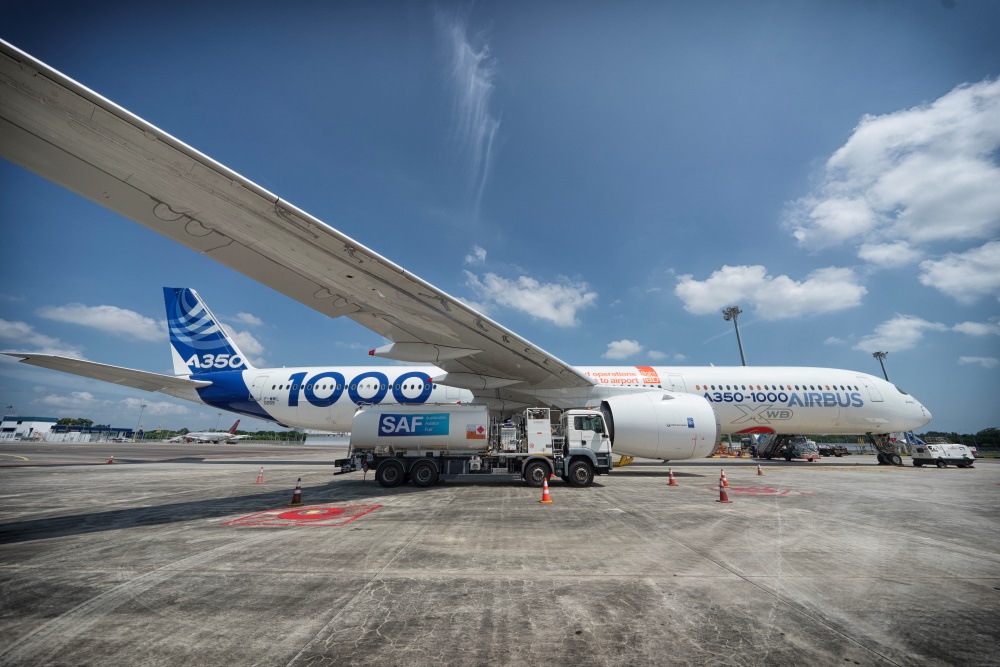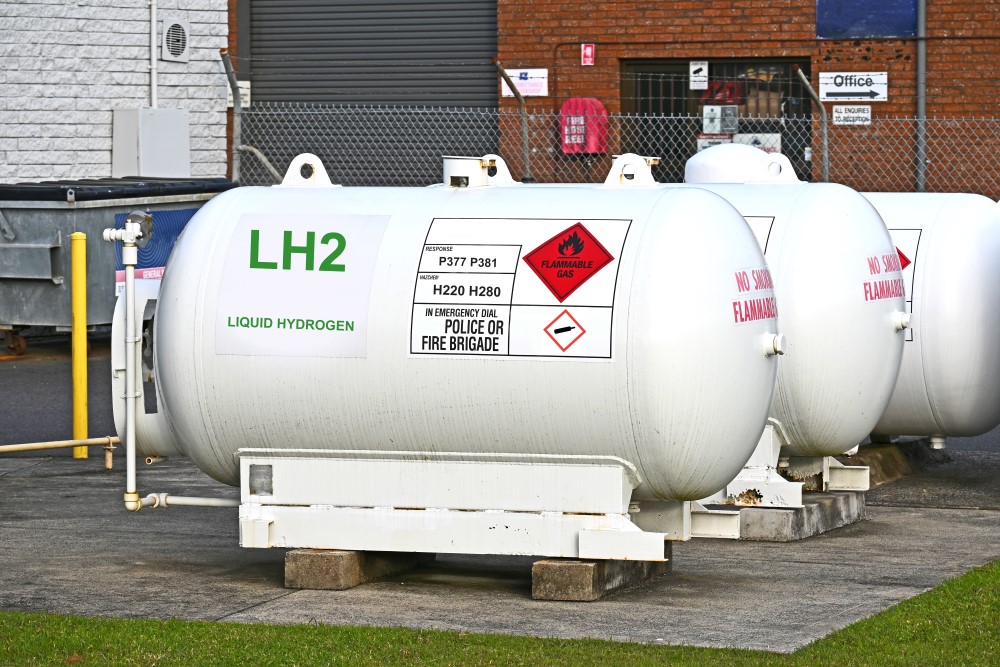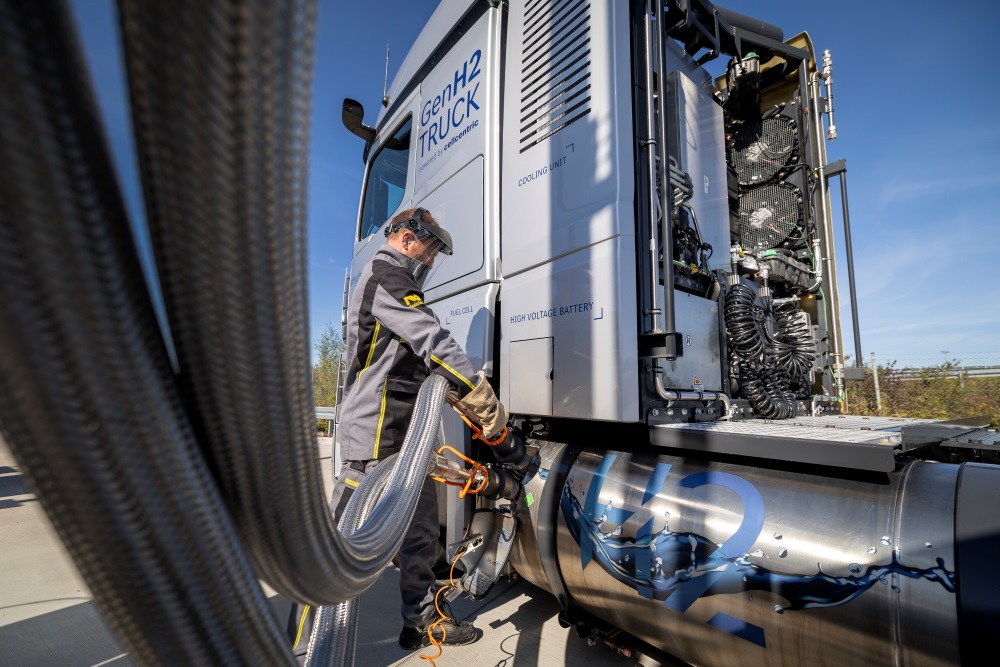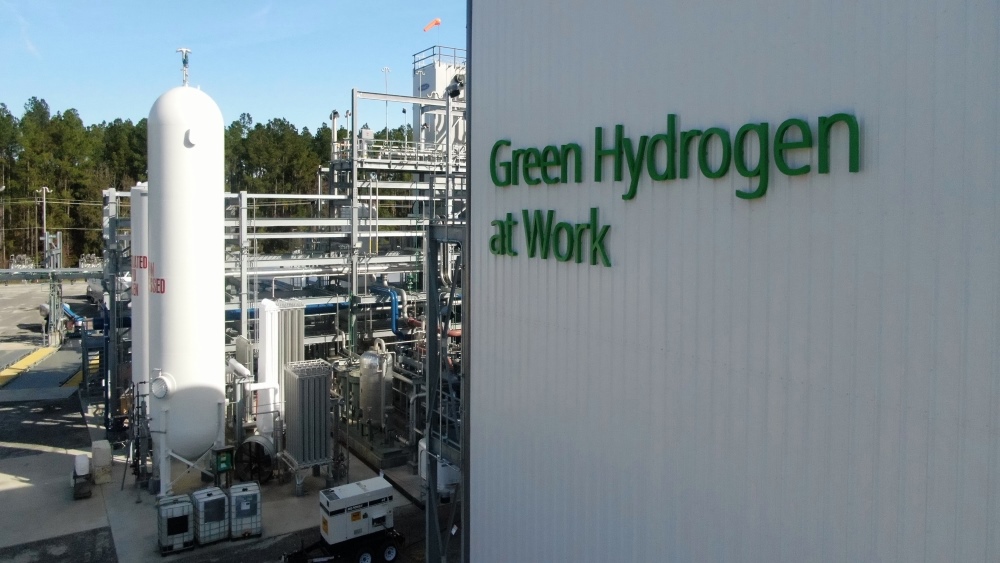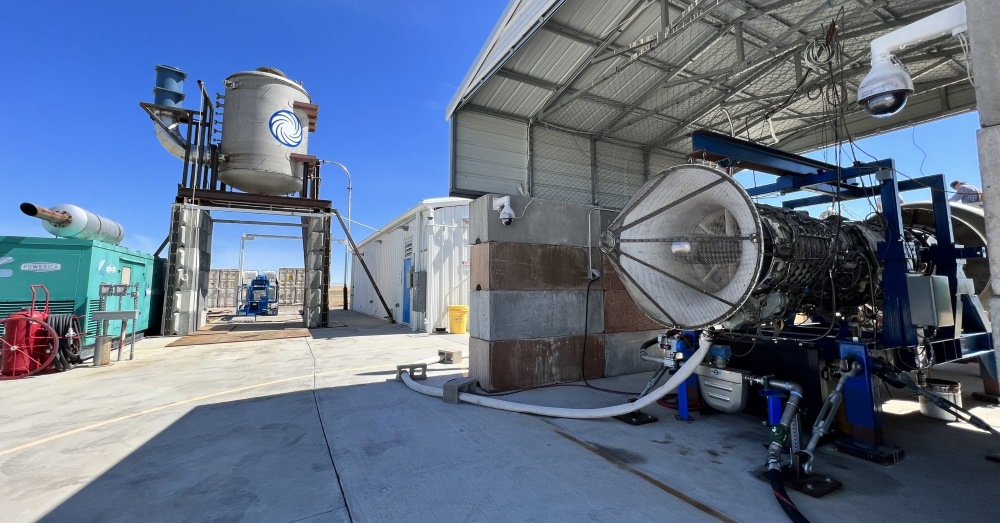About 8 gigatonnes of CO₂ are emitted by the global transport sector each year. Almost half of that is from cars. Just over a quarter is from trucks, buses, and lorries. About one-eighth is from shipping, and another one-eighth is from aviation.
Putting aviation into the context of other transport modes shines the spotlight on battery electric vehicles (BEVs) and land-based hydrogen mobility. So, it is no surprise that these sectors have received so much attention in the past five years and BEV titans such as Tesla and BYG have emerged.
Taking another view, aviation CO₂ emissions are 1 billion tonnes per year, similar to the total annual CO₂ emissions from Germany or Canada. And aviation CO₂ emissions are rising faster than other transport sectors. With this context, the imperative to defossilise the aviation sector becomes clear.
Green hydrogen can be produced from renewable electrical power. This clean energy vector may unlock the key to sustainability in the aviation sector.
Power for propulsion
Long-mission duration drones were the first major application of hydrogen for aviation. Agricultural crop surveillance, gas pipeline condition monitoring, and the military have all deployed hydrogen-fuelled drones.
Compressed gaseous hydrogen stored in a lightweight Type 4 composite cylinder can flow through a fuel cell mounted on the drone. This can achieve a significantly longer range than a battery-powered drone with a similar payload.
The first wave of hydrogen-fuelled aircraft were turboprop aircraft with powerful fuel cells to drive the propellors. Airbus, Zero Avia, Ruixiang, H2FLY, Sirius Jet, and Pipistrel have all experimented in this way.
High-temperature PEM fuel cells are currently favoured for aviation, due to their high power density. These fuel cells can generate more than 1 MW for each power pod.
More recently, testing of hydrogen-fired jet engines has taken place, with Rolls Royce and Easyjet confirming successful land-based firing of an AE 2100-A regional jet engine on a test bed in 2022.
Held back by the force of gravity
For land-based fuel storage and use, the volume of the fuel is often more important than its mass. For example, at a crude oil storage terminal, the mass of the fuel is of little consequence since it is borne by the land on which each storage tank sits.
In aviation, both the volumetric and gravimetric energy density are of critical importance. In a commercial aircraft, volumetric density plays a role since space must be available for fare-paying passengers.
Both liquid and gaseous hydrogen have a remarkably high gravimetric energy density. This alone puts them in the running as prime aviation fuel candidates. However, the fuel alone is not the only consideration.
The total mass of the fuel and its container is critical when benchmarking fuels. On this basis, the efficiency of traditional hydrogen storage is very poor, with less than 1% of the weight of a Type 1 steel cylinder filled to 200 bar pressure being hydrogen and the remainder being steel. This equates to a gravimetric efficiency of 1%.
When using innovative, high-pressure carbon fibre Type 4 gas cylinders with a pressure of 700 bar (as are standard in hydrogen fuelled cars) the gravimetric efficiency of storage is still only 5%. This may be acceptable for a very light drones, but this is not adequate for commercial aviation.
Switching to liquid hydrogen means that under current technical limitations, a metal storage tank must be used. Even when using cryogenically compatible aluminium alloys in place of heavier steel, the gravimetric efficiency of liquid hydrogen storage is currently limited at around 30%.
Moonshot
For vertical take-off in a helicopter or drone, the focus shifts to gravimetric energy density as the key parameter. For space rockets, the weight issue is even more acute.
The first large-scale application of liquid hydrogen was as a rocket-fuel for NASA missions. The hydrogen storage sphere built in the 1960’s by CB&I at Lauch Complex 39B of Cape Canaveral’s Kennedy Space Center remained the largest liquid hydrogen storage tank in the world for many years. It has a usable capacity of 2,800 m³ of liquid hydrogen and was used for the Apollo and space shuttle launches.
In 2022, the crown for the world’s largest liquid hydrogen storage tank was passed to a larger tank at Kennedy Space Center. Again, CB&I was awarded the contract to build a new tank of 4,700 m³ capacity at the same launch complex. The larger volume can support longer missions, and a more modern design with improved insulation will reduce liquid hydrogen boil-off losses.
Onboard NASA’s rockets, ultra-lightweight composite tanks have been used. The advantage of this type of construction is that a gravimetric efficiency of between 75 and 85% can be achieved. On the other hand, tanks of this type can be used only once.
For commercial aviation, the idea of a single-use tank would not be realistic. However, multiple-use composite tanks to store liquid hydrogen are under development. This technology may offer the prospect of achieving a gravimetric efficiency of more than 50% in a reusable tank.
The fourth phase of matter
Working on the materials of construction for the tank is one lever that can improve the gravimetric efficiency of liquid hydrogen storage. Exploiting the thermodynamic and physical properties of hydrogen is an alternative.
As hydrogen is compressed, its density progressively increases. For example, at 350 bar, a compressed gas cylinder with a volume of 1 litre contains 16 grams of hydrogen. At double the pressure, the same container holds 27 grams, almost twice as much
When hydrogen is cooled to a cryogenic liquid, its density reaches 36 grams of hydrogen per litre. Beyond the gaseous and liquid phases of matter, there is an additional fourth phase known as a ‘super-critical fluid’. In this phase, when hydrogen is both cold and compressed, its density is greater than normal atmospheric pressure liquid hydrogen. At 300 bar, a 1-litre storage tank of cryo-compressed hydrogen would contain 40 grams.
In many applications, the advantage of cryo-compressed hydrogen may not justify the additional complexity of this medium. However, in aviation, the gravimetric energy density is so critical that cryo-compressed hydrogen may be applied in this niche.
Zero Avia, based in the UK, and the US startup VERNE announced their collaboration to explore the use VERNE’s cryo-compressed hydrogen storage solution for aviation. Also of deep importance is that in addition to having a higher gravimetric energy density, the energy input requirement to densify VERNE’s cryo-compressed hydrogen is approximately half the electrical power required to produce liquid hydrogen. As hydrogen aviation scales up, this energy saving for cryo-compressed hydrogen could equate to many MWh of avoided power usage.
Help from helium
Achieving high energy efficiency in the hydrogen supply chain is imperative. This message has clearly been understood by the US company GenH2. Their concept is to use a little power to save a lot of energy.
GenH2 technology relies on helium being cooled in a Brayton refrigeration cycle to a temperature about 10°C colder than -253°C, the temperature at which hydrogen liquefies at atmospheric pressure. This helium sub-cools liquid hydrogen over a heat exchanger to make sLH₂. There is a power penalty involved in operating the helium compressor in the Brayton refrigeration cycle; however, the boil-off losses of hydrogen in the supply chain are reduced.
When cryogenic liquid hydrogen sits in a storage container for more than a few hours, a tiny amount of ambient heat begins to ‘leak’ through the storage vessel insulation and vaporise the hydrogen. Over a long duration, the pressure in the tank can build up to the point where safety devices fitted on the tank release the pressure.
When hydrogen is vented, not only does this represent a loss of cold energy that was required to liquefy the hydrogen, but it also represents a loss of the energy that was required to produce the hydrogen itself. So, avoiding boil-off venting can justify some additional amount of power for sub-cooling liquid hydrogen.
Sub-cooled hydrogen has not yet been used in aviation, but for several years it has been considered the fuel of choice for hydrogen storage onboard Daimler Trucks. This technology is now being piloted at a commercial scale: Linde and Daimler Truck opened the first sLH₂ refuelling station at Wörth am Rhein in Germany in February of 2024.
Scaling up liquid hydrogen infrastructure
90% of global hydrogen liquefaction capacity exists in North America. NASA programs catalysed the demand, and liquid hydrogen capacity additions in North America continue to outpace the growth of hydrogen liquefaction in Europe and Asia.
In Canada, Air Products has operated a 30-tonne per day hydrogen liquefier for many years. Air Liquide at Bécancour has a liquefier with a capacity of 10 tonnes per day. Through the course of 2023 and 2024, Plug Power has started up 15-tonne per day hydrogen liquefiers in Georgia and Louisiana.
Just north of Las Vegas in Nevada, Air Liquide inaugurated their 30-tonne per day liquefier in 2022. The site, which also produces and stores hydrogen, represented an investment of $250 million for the company.
The compact nature of Europe’s industrial base in the northwest of Germany, the Netherlands, Belgium, and northern France has favoured the economics of compressed gaseous hydrogen distribution by road. This, combined with two comprehensive hydrogen pipeline networks in this industrialised region, has historically subdued the need for liquid hydrogen infrastructure.
In Europe, the 10-tonne per day liquefier operated by Air Liquide at Waziers in France is Europe’s largest hydrogen liquefier. Air Products operates a 5-tonne per day liquefier in the Rozenburg part of the Port of Rotterdam, the Netherlands, and Linde operates two similar capacity units in Germany.
In 2022, Air Products announced the construction of a new hydrogen liquefier at Botlek, which will double Europe’s hydrogen liquefaction capacity when it opens in 2025. Aviation and other emerging mobility applications of liquid hydrogen are likely to see similar hydrogen liquefier capacity expansions and drive Europe in a similar direction to North America.
Simplified supply chain
In addition to hydrogen liquefiers being scarce, the absence of liquid refuelling infrastructure at airports would be a bottleneck to the adoption of cryogenic liquid hydrogen in aviation.
The construction of multiple fuelling locations at a single airport, with the installation of cryogenically insulated liquid hydrogen pipelines running underground, would be an enormous engineering challenge to undertake at great cost.
To kick-start access to liquid hydrogen for aviation, the startup Universal Hydrogen has conceived a removable, refillable liquid hydrogen storage tank and supply chain concept. The company is based both in Toulouse, where Airbus has one of its main manufacturing locations, and in Hawthorne, California.
During their period as an active startup and pioneer of hydrogen aviation, Universal Hydrogen proposed to use cryogenically insulated, metal containers with more than 1,000 litres of capacity to store liquid hydrogen. The containers can be rolled on and off the aircraft in the same way that luggage waggons are currently used to load and unload passengers’ suitcases. The containers are moved by truck to a central filling location and then distributed to the aircraft.
The Universal Hydrogen concept avoids liquid hydrogen tankers moving around the airport to refuel fixed tanks on the aircraft. It also eliminates the need for static storage and refuelling equipment in multiple locations on the airport apron. Perhaps aspects of their vision will be adopted in the future, despite their recent bankruptcy.
Hurray for hydrogen derivatives
Given the challenges associated with storing gaseous hydrogen and the immaturity of the liquid hydrogen supply chain, alternatives to hydrogen are being considered for sustainable aviation.
Green ammonia is a zero-carbon fuel. It can readily be liquefied and stored as a liquid at low pressure in lightweight containers. Whilst it has a lower gravimetric energy density than hydrogen, liquid ammonia has a higher volumetric energy density than liquid hydrogen. Furthermore, when considering the gravimetric efficiency of the storage system, liquid ammonia can approach liquid hydrogen for the combined gravimetric energy density.
Ammonia can be partially cracked using high-temperature waste heat from a jet engine and then burned in that engine. It can be stored in the aircraft wing, in a similar way to kerosene today. Reaction Engines in the UK and Aviation H2 in Australia are developing specialist equipment components that may one day enable the use of ammonia as a fuel for jet aircraft.
Synthetic aviation fuel, or e-SAF is a sub-category of sustainable aviation fuel (SAF). It is produced when green hydrogen is combined with CO₂. E-SAF can be burned in conventional jet engines, avoiding the cost of new aircraft and eliminating the need to implement new infrastructure for hydrogen storage and refuelling at airports.
E-SAF is a hydrocarbon fuel that releases CO₂ when burned. However, since it consumes CO₂ during its production, this is a circular use of CO₂ that neither increases nor decreases the amount of CO₂ in the atmosphere over the long term. Furthermore, the use of e-SAF avoids the use of petroleum-derived kerosene. This means it displaces fossil fuels and contributes to a reduction in anthropogenic CO₂ emissions.
E-methanol can also be produced as a green hydrogen derivative. Methanol can be reformed to syngas and then fed to a high-temperature PEM fuel cell to provide motive power for turboprop aviation. Methanol is less toxic than ammonia, which may make it attractive for passenger applications. As a liquid with a low vapour pressure, it can also be stored in the wing of the aircraft to enable long flight missions.
About the author


